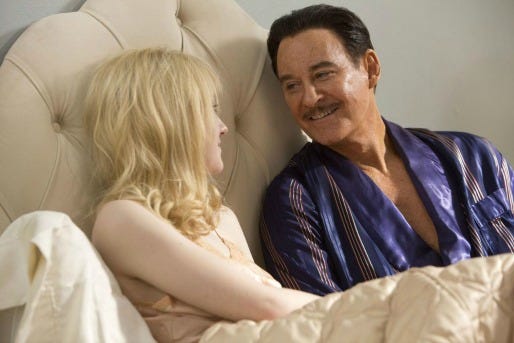The Last of Robin Hood

More than 20 years ago Kevin Kline had a lovely performance in “Chaplin” as an aging movie star playing out his last hand as a wastrel playboy. He was so good as Douglas Fairbanks that when it came time to cast someone as Errol Flynn in his declining years for “The Last of Robin Hood,” Kline seemed an obvious choice.
He terrifically captures Flynn’s fizzy, rakish persona, which showed little difference between his on-screen swashbuckling and his off-screen adventures. (Flynn chronicled them himself in his posthumous autobiography, “My Wicked, Wicked Ways.”) He spent so much time carousing, drinking and drugging, seducing young girls, sailing on his yacht and otherwise dribbling out his days, it’s hard to believe he found time to make movies.
Done up with Flynn’s signature pencil mustache and cravat-and-evening-jacket outfit, tumbler of booze perpetually in hand, Kevin makes for a pretty spot-on physical impersonation, too.
(Normally I would feel compelled to point out that, at nearly age 67, Kline is rather too old to play Flynn, who died at 50. But Flynn’s hard-charging lifestyle aged him prematurely. And Kline, in several shirtless outings, flaunts a surprisingly athletic figure that helps the age concerns vanish.)
“Robin Hood” takes its title from perhaps Flynn’s most famous role, but focuses on the last two years of his life when his star had fallen and he worked only itinerantly. He notices a young starlet, Beverly Aadland (Dakota Fanning), and in the classic Hollywood seduction method, sends a flunky to fetch her.
Their initial coupling is, to say the least, brief. Not surprising, considering this is a man who was charged with statutory rape in 1942 (and acquitted) and bedded so many ladies they coined the phrase “In like Flynn.”
But a couple of factors work to sustain the relationship beyond a one-night stand. First is Flynn’s profound self-awareness, including the thought that that his ability to attract women is rapidly waning, and he’d rather not be left alone at the end of the party. The other is a certain Machiavellian aspect to Beverly: the sense that she’s using him as much as he is her.
This is honed and encouraged by her mother, Florence (Susan Sarandon), a showbiz mom who pushes her daughter to sing, dance and act her way to easy street. In Beverly’s case, the talent is not an even match with the ambition, so when Flynn turns up offering to “help” the girl’s career, Florence offers a few perfunctory objections before signing on.
Of course, there’s more revelry than actual opportunity. At one point Errol and Beverly disappear for five months to Africa, and in the finished film she only has one line of dialogue. But the pair seem to be a genuinely affectionate couple, with Florence often tagging along as chaperone.
At some point I should mention that Beverly is only 15 when she and Flynn start dating, and just 17 when he dies. This comes as a shock to him when he finally learns it, though not so much to quit the affair. Obviously, this information puts the entire dynamic of the relationship in a different, disturbing light.
Writing/directing duo Richard Glatzer and Wash Westmoreland tell the story from a flashback perspective, with Florence narrating her side of events to a book author after Flynn has passed and a media firestorm erupts over his teenage damsel. Sarandon paints a picture of a profoundly deluded woman, who gave up her own dreams of stardom to push her kid to unwholesome lengths.
If the movie has a weakness, it’s that Flynn and Florence are vivid, engaging characters and Beverly remains something of a cipher. Fanning does what she can with the material, but the script doesn’t lend her a lot of opportunities to reveal the character’s interior architecture.
But “The Last of Robin Hood” is worthwhile, if for no other reason to see Kline scamp and strut as the iconic bad boy. “When the legend becomes fact, print the legend,” goes the classic Hollywood line — one that could’ve been written about Errol Flynn.
4 Yaps



